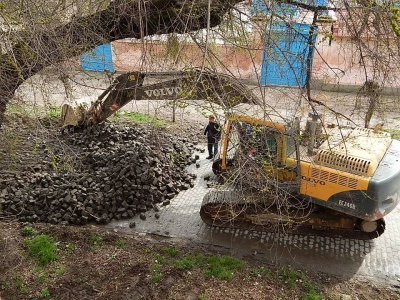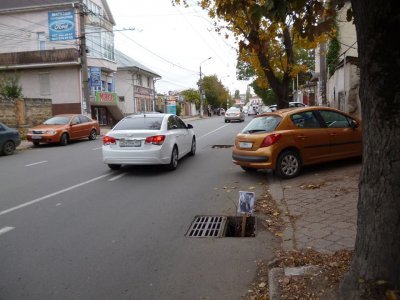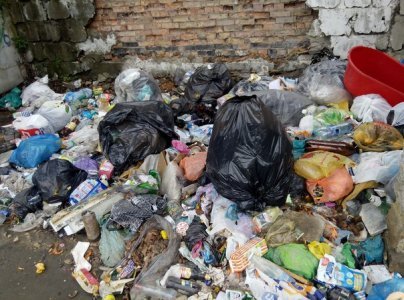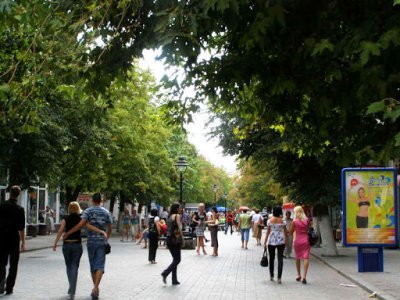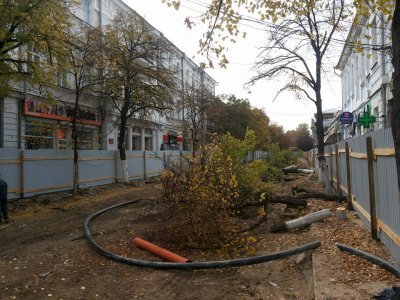A name of the Crimean capital translated from Greek means “city of common good”, “city-collector”. However, traffic jams, garbage, widespread advertising of drugs and holes on the newly renovated roads are a visiting card of Simferopol today.
Transport collapse
A few years ago, Simferopol proudly called itself “gates of Crimea”. “My Simferopol – gates of Crimea” – the railway station, where millions of tourists have arrived before the annexation to go to various corners of the peninsula then, welcomed passengers with the words of the city anthem. Now the Simferopol railway station has become a ghost: there are only electric trains coming to its platforms. However, the airport began to serve more flights, but not from different countries as it was earlier – just from Russia. The Crimean capital more and more looks like a crocked bottle head, from where you can not escape easily, due to an abundance of cars in the narrow streets.
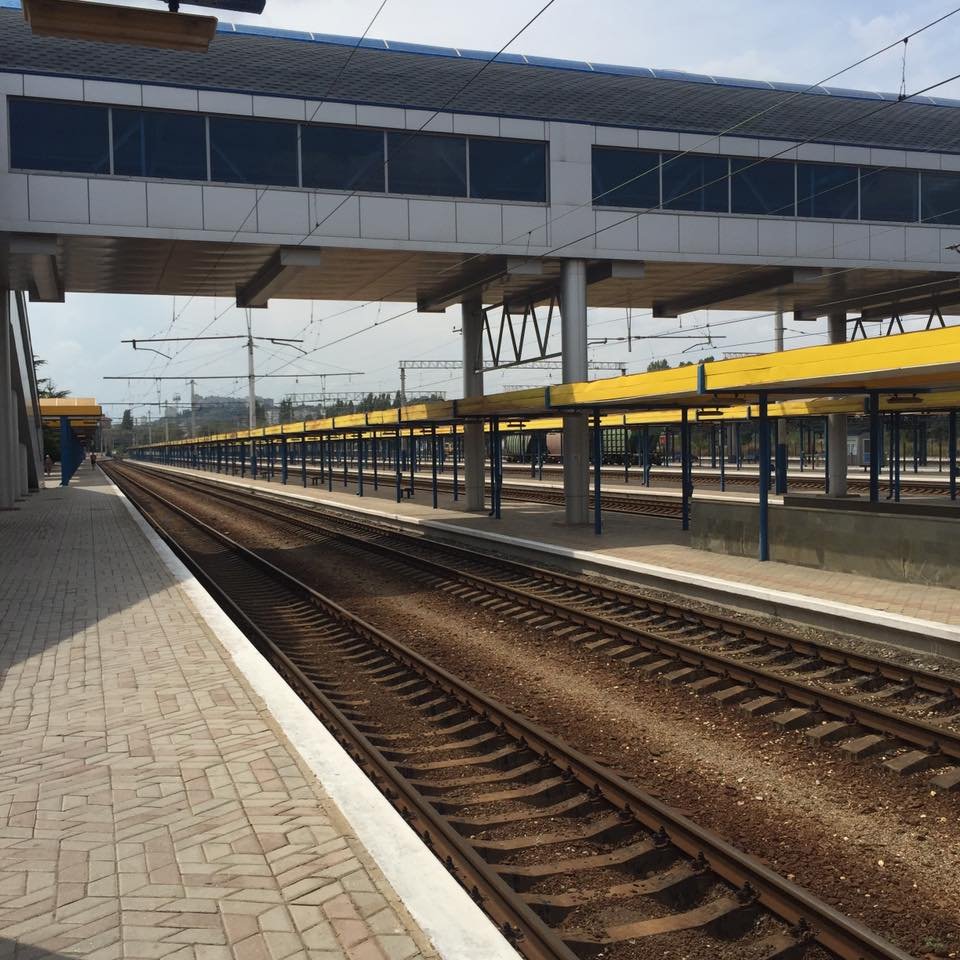
The way the Simferopol railway station looks even in summer
One of the first problems Simferopol people have experienced since the beginning of the occupation is traffic jams – first, in usual places (for example, at the intersection of Vorovskogo and Shmidta streets or from the Kuibyshevsky market to the Sovetskaya square), now – here and there and everywhere. The main reason is a sharp increase in the number of vehicles, including due to the Russians that came – “interlopers” as dissatisfied citizens call them. Of course, the narrow streets of the city can not serve this traffic flow. In addition, due to a lack of parking lots, drivers leave their cars on the roadway preventing the traffic on the road. And numerous repair works with no end in sight became the final nail in the coffin of citizens’ patience.
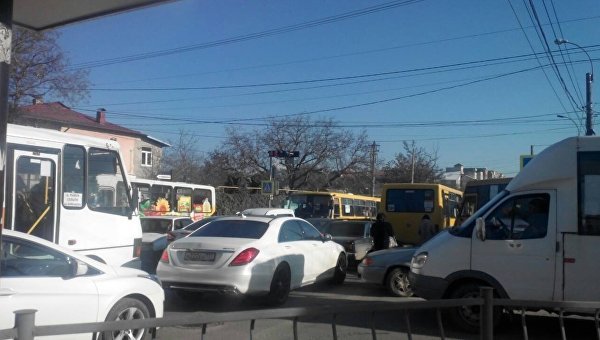
Road repairs
2016 became a truly epochal year for the Crimean capital – they repair everything: facilities required to be repaired and the ones that would stay for another 50 years. This happened to the Zhigalina street, where the perfectly good stone-block pavement has been laying since the post-war era, but local “authorities” decided to remove it (local citizens believe that not it serves to decorate someone’s property). However, they didn’t have enough money for the asphalt, so the people living on this street have to get home off roads. In his turn, the “mayor” of the Crimean capital Gennady Bakharev promises to finish the repair works in two weeks one day and in a month another day. There is the same picture on the Genova street or Provodnikov alley – roads have been staying excavated for several months, but the contractors are in no hurry to repair on the ground of a lack of funding from the city treasury.
Removing the stone-block pavement on Zhigalina street
Intersection of Genova street and Provodnikov alley
Provodnikov alley
In September, several major projects were started in the city at the same time: the repair of the eastern diversion route and Yaltinskaya and Sevastopolskaya streets that almost completely paralyzed the city. The citizens would bear everything if it were not for one slight problem: the roads are repaired in such a way that it will be needed to redo them in six months. For example, there were hollow spots on the Krylova and Krasnoarmeyskaya streets in a few months after repairs. And this is because the asphalt was laid without solving the problems of storm and sewage runoffs, which are undermining the road surfacing now.
The situation with road sanitary sewer manholes and storm water drains that had sunk in and now are gaping with road holes up to 30 cm in depth is even worse. If your wheel gets into this hole, you will not get a tire fitting station.
Laying asphalt on runoffs at the intersection of Krasnoarmeyskaya and Krylova streets
A manhole on renovated Kozlova street
Shmidta street
However, one of the city’s streets turned into a local “highway” – this is the Futbolistov street that leads to the house of the Crimean “head” Sergey Aksenov. There are both the asphalt laid in a quality manner and pedestrian crossings made. But the people living on other streets of the Crimean capital have to get the “motor highway” making their way between trenches of pits.
Municipal transport
A serious problem for the city was reducing the number of minibuses – in June 2016, the city “authorities” suspended the contract with SimSitiTrans transportation company that served the most city routes due to the fact that the owner of this company is a coordinator of the “civic blockade” of Crimea Lenur Islyamov. Moreover, since the beginning of the fall, the city people have got another surprise: the “government” announced the optimization and reduced the number of routes by one third – from 69 to 48. So now Simferopol people have to wait for a minibus for 20-40 minutes (the waiting time on certain routes may increase up to an hour in the evening).
“I don’t know who came up with a bright idea to reduce the routes in the city!? So to speak, to optimize. There have been problems on many routes for a couple of months! We have been living and getting home without any problems, and then bang! there is no way to get home…” Svetlana Efimova wrote in a group “Black list of Simferopol” in the VKontakte social network.
The city “authorities” have promised to solve the problem by providing up to 100 new buses on the streets. However, as long as there are no buses available, Simferopol people have two options: either stay at bus stops for 40 minutes or walk on foot.
Dirty city
Another problem that the Crimean capital can not handle is illegal garbage dumps that occur now and then in different places – near garbage containers, trash cans and even in the city center, near the once-largest cinema.
Waste deposit near trash containers
Garbage near the former cinema “Simferopol”
Trash can in the Simferopol center
Local communal services fail to clean them and even record new garbage dumps in due time. Neither raids nor the change of administration leadership can help – Simferopol is buried in the garbage. There are two reasons for this: they started to drop more litter in Russia and the companies that won tenders do not hurry to clean up.
The last “know-how” of the Simferopol “government” is to deal with illegal dumping by using video cameras that they promised to put near trash containers. However, it is unlikely that this measure will be effective. But Simferopol people seemed to forget that it is clean where nobody drops litter but not where there are many street cleaners and video cameras.
City center reconstruction
In early autumn, the city center reconstruction works were started in the Crimean capital: Karla Marksa and Pushkina streets were partially closed with the fence, behind which, as it turned out, it is easy to “split” the budget money. Public activists skeptically looked at “government” plans from the beginning of reconstruction and even publish an electronic petition against this modernization of the city center.
However, the “government” had its own views on this matter and the Pushkin street was easily deprived of perennial lime trees having cut up the trees under the guise of reconstruction – allegedly they disrupted communication lines. Although they promised to remove only diseased trees, everything was cut down without distinction. In return, they promised to plant large trees brought from Krasnodar, which, according to environmental experts, are unlikely to survive.
Pushkina street before reconstruction
Pushkina street without trees
And all this is done only to use (read – to split) the budget money. The “head” of the Committee on economic, fiscal and tax policy of the Crimean “Parliament” Igor Lukashev said about that honestly.
“If you don’t know, I need to use this money, conduct and finish before the end of the year. Otherwise, it will be a fine and other things,” the “deputy” said not hiding true goals of reconstruction and replacement of trees.
By the way, Simferopol decided to do with trees and shrubs: the city “authorities” promise to conduct an inventory and then the tree renewal and the sanitation pruning. They renewed trees on Shpolyanskaya street in such a way that there are just stubs left. But it was not enough – they decided to cut 4,000 trees for firewood. However, later they changed their minds and recognized that they didn’t have the funds, and delayed the mass cutting down of trees till the next year.

Sanitation pruning of trees on Shpolyanskaya street
Pawnshops, drugs and homeless people
The advertising that accompanies us everywhere today allows to understand the city’s life. Now there is the advertisement of pawnshops on every street corner in Simferopol – this is a sign of “increasing welfare” of the population. Small offices are ready to borrow you the money just on your passport, so they replace the usual offices and shops insistently.
The second service having the intrusive advertising in Crimea is synthetic drugs, which you can easily buy in the city. The clichéd notes “salt” and “spice” with contacts to order “decorate” the front doors, walls of buildings and garages and even a police station building.
In autumn, another problem was added to numerous problems of Simferopol people: the city was occupied by homeless people and beggars, who have come here from all over the country. The “government” admitted that they didn’t know how to solve this problem yet, and Simferopol people meanwhile, pass by stray visitors with caution.
The “city of common good” has changed its look completely for two and a half years of the occupation – the railway station became empty, there are just stubs instead of perennial trees, and offices and shops are replaced with pawnshops. But this is just the beginning – in a few years of conducting this policy, the Crimean capital has all chances to become a faceless provincial town – “a hick town S…”.
Olga Efimova





